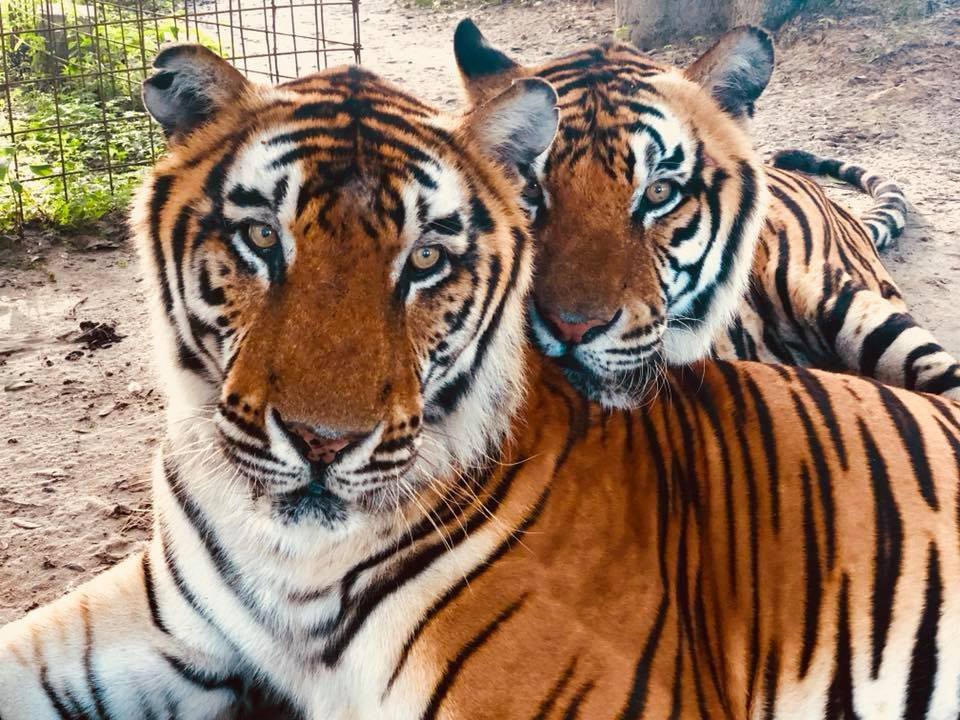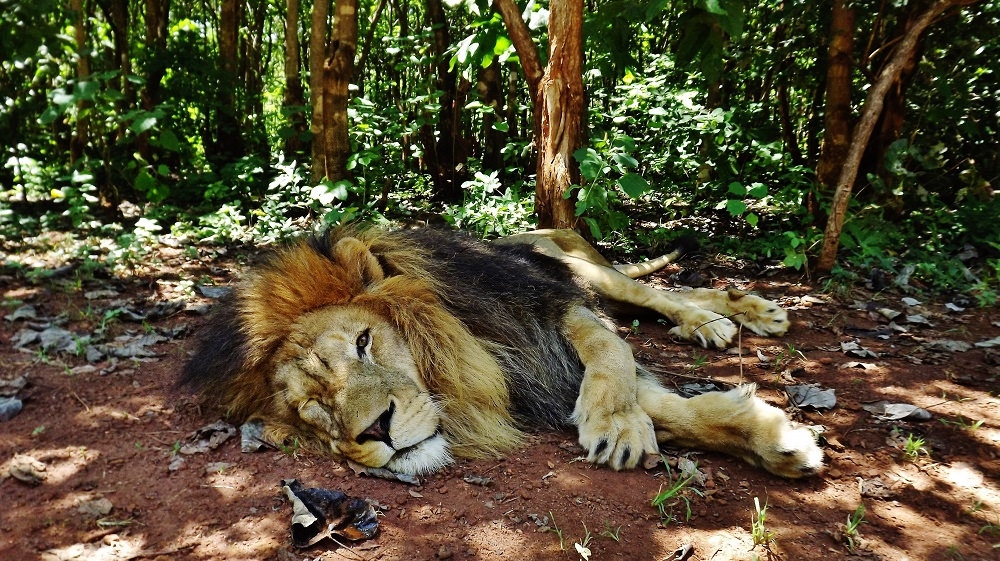A version of this article previously appeared on Here & There Collective.
Frosty & Apollo relaxing at their accredited sanctuary home, The Big Cat Rescue in Florida, United States.
You’re an animal lover and you’re going on vacation.
Like any animal lover, the opportunity to see or interact with wild animals in an attraction, unlike a zoo, that more closely simulates the animals’ natural environment is an exciting possibility!
But, you believe wild animals should be free and understand that many wild animal tourist attractions abuse, mistreat, and exploit their animals for profit, so you make commendable efforts to seek out ethical facilities.
At the top of your list are sanctuaries and rescue centers who rescue their animals from neglectful situations or who are retired from work and cannot be released back into the wild.
In your research, you visit a well-advertised sanctuary’s glossy website, which makes claims about the high standards of care their rescued animals receive.
You read a vague, yet compelling backstory on the sad origin of their rescued wild animals, who are now living their lives happily and free from harm.
Perhaps there’s a segment on the tragic plight of their species, which is caused by deforestation, poaching, or some other human-caused ill. You figure that there’s nothing wrong with the various face-to-face activities offered at the attraction – elephant rides, cub petting, etc. – because you believe it’s all in the name of conservation and education. The animals are surely better off now than they were before; they’ve been rescued, after all.
But, just to verify the claims made on the website, you do your due diligence as a responsible tourist and seek out unbiased reviews from other tourists who have already been there. You are relieved to find that, overwhelmingly, their reviews are glowing and you move forward with making your reservation.
Probably not.
And this is part of an insidious problem within the booming industry of wildlife-based tourism.
In 2017, over 1 billion people traveled; international tourist arrivals grew by 7% against the prior year. Wildlife Tourist Attractions may account for 20-40% of global tourism.
Tourists who wish to participate in wildlife-related tourist attractions have become increasingly aware of animal welfare concerns – thanks largely in part to general public awareness, and to documentaries like Blackfish.
So, in an effort to avoid zoos and attractions that are known to be abusive, many tourists look to experiences at sanctuaries or rescues.
What Defines an Animal Sanctuary?
The Global Federation of Animal Sanctuaries defines a sanctuary as:
… any facility providing temporary or permanent safe haven to animals in need while meeting the principles of true sanctuaries: providing excellent and humane care for their animals in a non-exploitative environment and having ethical policies in place, regarding: tours, commercial trade, exhibition, acquisition and disposition, breeding, and more.
Unfortunately, “sanctuary” and “rescue” aren’t regulated terms; many tourist venues intentionally use those terms to lure well-meaning tourists to their parks despite the fact that they can’t prove their animals were actually “rescued”, do not meet established standards of care, breed their animals, or actively engage in neglectful, abusive, or harmful handling and activities.
Additionally, many of these venues promote themselves as eco-minded or conservation-based but actually offer little or no conservation benefits.
They’re most likely engaging in practices that are damaging to the animal, but also damaging to the public perception of the animal and what their actual needs and behaviors are.
To further compound the problem, many visitors to these attractions simply have no idea what goes on behind the scenes or don’t know what problems or concerns to even look for.
A relatively recent report published in 2015 studied and scored the conservation status and welfare impacts of animals in 24 types of Wildlife Tourist Attractions (WTA) and then compared their findings to tourists’ reviews on TripAdvisor.
Of the 24 attractions studied, 6 WTA’s had net positive conservation and welfare impacts, 14 had negative conservation impacts, and 18 had negative welfare impacts.
In other words, the overwhelming majority of WTAs studied were bad for the animals.
However, only 7.8% of all tourist feedback on these WTA’s contained anything negative regarding the welfare or conservation of the animals.
This suggests that poor animal welfare standards and other problems at various WTAs go unrecognized by tourists, who are not properly educated or equipped with the knowledge to identify them.
Take elephants, for example, one of the most popular and sought-after animals at WTAs.
From World Animal Protection Australia’s report Taken For A Ride
It can be difficult for an untrained person to identify signs of distress or discomfort in elephants. Apart from the typical stereotypical swaying, distressed elephants do not always display distress that clearly. Elephant body language can be difficult to interpret and is not comparable with the body language of domesticated animals we are familiar with.
Even the most well-meaning tourist, lured by an attractions’ promises and commitment to the conservation and protection of the species in their care, can miss the signs of neglect, abuse, or substandard care.
To further illustrate the disconnect between perception and reality, let’s consider marine parks.
Ever since the release of Blackfish, public awareness of how detrimental marine parks like SeaWorld are to the health and well-being of their animals is widely known and accepted. Attendance at marine parks around the world has plummeted.
And yet, a visit to the TripAdvisor page for Sea World, San Diego yields almost 4,000 “Excellent” reviews and 2,100 “Very Good” reviews out of around 7,500 total reviews. Even when mainstream opinion decries the captivity or marine mammals like whales and dolphins, many are still blind to the damage it causes.
This just perpetuates the cycle of misinformation and funnels more tourists to these types of attractions.

Simba the lion lounging at his home, Lilongwe Wildlife Trust, which is the only accredited wildlife sanctuary in Malawi. In addition to serving as a sanctuary for many animals who cannot be released back into the wild, Lilongwe has a rescue and rehabilitation unit, an emergency wildlife response unit, and leads clinical interventions and veterinary research through their program One Health. They are very transparent in everything they do and provide annual impact reports.
How to Spot a Potential Problem: Do They Offer Direct Contact with the Animals?
A selfie with an animal might seem pretty harmless.
Perhaps you’ve been enticed by a “rescue” in Africa where you’ll volunteer to hand raise “orphaned” lion cubs for the purpose of “conservation,” or yearn to trek through the jungle atop an elephant’s back.
Unfortunately, these are the most obvious indications that a sanctuary is not reputable.
Stay away from any attraction that offers direct interaction with animals.
The general rule is that if you can hug, ride, touch, or take a selfie with a wild animal it is NOT legitimate, or does not have the welfare of the animal as their paramount priority.
Take elephant riding, which remains a popular tourist attraction; a simple Google search will yield countless opportunities to take a jungle trek atop an elephant’s back in places like Thailand and Bali.
What many tourists to these venues don’t know, is that any elephant performing tricks, or allowing humans to ride their backs, endured an awful training process literally referred to as “The Crush,” because the entire process is intended to break their spirit so that they comply with commands.
From World Animal Protection Australias’ report Taken For A Ride
The few minutes a tourist spends with an elephant during a ride do not reveal the true life of the elephant or what it has endured previously regarding contact with tourists and giving rides.
For example, shows offering elephant painting may seem harmless. But getting an elephant to paint requires extremely intensive training to get the animal to obey the mahout during the performance. While it is easy to understand that elephant painting or playing football is not a natural activity for elephants, the venues rely on the ‘cute’, exotic and novel factors of these activities. “
Although the brief interaction of riding allows the tourist to appreciate the elephant’s bulk and beauty it disguises the daily boredom, physical hardship and relentlessness of tourist treks. It also hides the confinement endured at other times.
Read more about finding accredited animal sanctuaries on Here & There Collective.
__
Also by Stephanie: PSA: NYC Bans Activated Charcoal Foods—What To Know About This Fad Ingredient
Related: What You Should Know About Coconut Oil and Animal Exploitation
Sugar Gliders Are The Cutest–But Buying Them As Pets Is No Way to Love Animals
Get more like this—Subscribe to our daily inspirational newsletter for exclusive content!
__
Photo: The Big Cat Rescue, Liongwe

